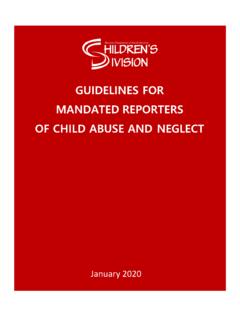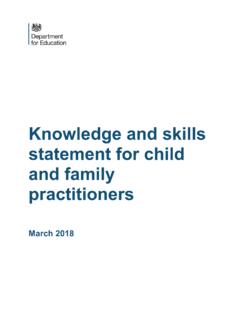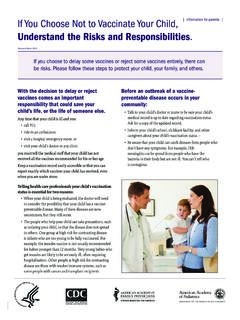Transcription of SSNRS for Parents - Centers for Disease Control and …
1 Children Benefit When Parents Have Safe, Stable, Nurturing Relationships What are safe, child abuse and neglect is a preventable public health problem affecting millions of families. stable, nurturing relationships? child maltreatment includes all types of abuse and neglect of a child under the age of 18 by a parent, caregiver, or another person in a custodial role ( , clergy, Safety: The extent to coach, or teacher). child maltreatment is a serious problem that can have lasting which an individual harmful effects. The few cases of abuse or neglect seen in the news are only a is free from fear and small part of the problem, as many cases are not reported to police or social secure from physical services.
2 What we do know is that: or psychological harm within their social, In 2015, an estimated 683,000 children were victims of physical, and work In 2015, more than 1,670 children died from child abuse and neglect . environments. about 75% of deaths occurred among children younger than age Stability: The degree The total lifetime economic burden resulting from new cases of fatal of predictability and and nonfatal child maltreatment in the United States is approximately consistency in one's $124 relationships as well as the social, emotional, child abuse and neglect is a complex problem rooted in unhealthy relationships and physical and environments. The goal for child maltreatment prevention is clear: to stop environments.
3 child abuse and neglect from happening in the first place. Nurturing: The extent to which Parents and Research suggests that safe, children have access stable, nurturing relationships to individuals who are between Parents and other able to sensitively and adults, in addition to those consistently respond to positive relationships between and meet their needs. Parents and their children, may help prevent child maltreatment from one generation to the next. Safe, Stable, Nurturing Safe, stable, nurturing relationships and environments are essential to Relationships for preventing child maltreatment and to assuring that all children can reach their Parents are good for full We know that healthy relationships between Parents and their children too.
4 They may children are important, but a recent special issue in the Journal of Adolescent help interrupt the cycle Health has shed light on the importance of safe, stable, nurturing relationships of violence and reduce between Parents and other adults in preventing child The role children's exposure to of safe, stable, nurturing relationships between adults might be especially abuse and neglect. beneficial for Parents who experienced abuse during their own childhood years. Nurturing relationships can protect against factors that might increase the risk for perpetuating abuse ( , stress) and they provide models for positive interactions and social support. National center for Injury Prevention and Control Division of Violence Prevention TM.
5 Children Benefit When Parents Have Safe, Stable, Nurturing Relationships child maltreatment in one generation is associated with child maltreatment in the next, but the cycle can be interrupted. It is important to know that past child maltreatment does not define a person. What You Can Do . Here are some steps you can take to incorporate findings from this research into your work: Enhance safe, stable, nurturing relationships in your prevention efforts not only between Parents and children, but also between Parents and other adults (including romantic partners, friends, neighbors, and relatives). Work on skills building and training to enhance Parents ' ability to access and maintain healthy relationships, recognizing that Parents who experienced maltreatment during childhood may need extra support in this area.
6 Add a module to existing multicomponent programs ( , nurse-family partnerships) to enhance and promote supportive and nurturing adult relationships for Parents . Establish partnerships with social services and other prevention organizations to coordinate efforts. Given that child maltreatment is associated with longer term behavioral and health problems ( , substance abuse ),5 it is necessary to have a comprehensive response. If safe, stable, nurturing relationships for Parents are promoted and enhanced, children will benefit. Resources: For information on child maltreatment prevention: CDC Special Supplement: Interrupting child Maltreatment across Generations through Safe, Stable, Nurturing Relationships: CDC Essentials for Childhood Initiative: Centers for Disease Control and Prevention.
7 Essentials for childhood: steps to create safe, stable, nurturing relationships and environments. National center for Injury Prevention and Control : Atlanta, GA, 2014. Preventing child abuse and Neglect: A technical Package for Policy, Norm, and Programmatic Activities: References: 1. Department of Health & Human Services, Administration for Children and Families, Administration on Children, Youth and Families, Children's Bureau. (2017). child Maltreatment 2015. Available from statistics-research/ child -maltreatment. 2. Fang X, Brown DS, Florence CS, Mercy JA. The economic burden of child maltreatment in the United States and implications for prevention. child abuse and Neglect 2012; 36:156-165.
8 3. 4. Schofield, T., Lee, R., and Merrick. M. (2013). Safe, stable, nurturing relationships as a moderator of intergenerational continuity of child maltreatment: A meta-analysis. Journal of Adolescent Health, 53, S32-S38. 5. Felitti, V., Anda, R., Nordenberg, D., Williamson, D., Spitz, A., Edwards, V., Koss, M., and Marks, J. (1998). Relationship of childhood abuse and household dysfunction to many of the leading causes of death in adults: The Adverse Childhood Experiences (ACE) Study. American Journal of Preventive Medicine, 14, 245 258. 1-800-CDC-INFO (232-4636)














